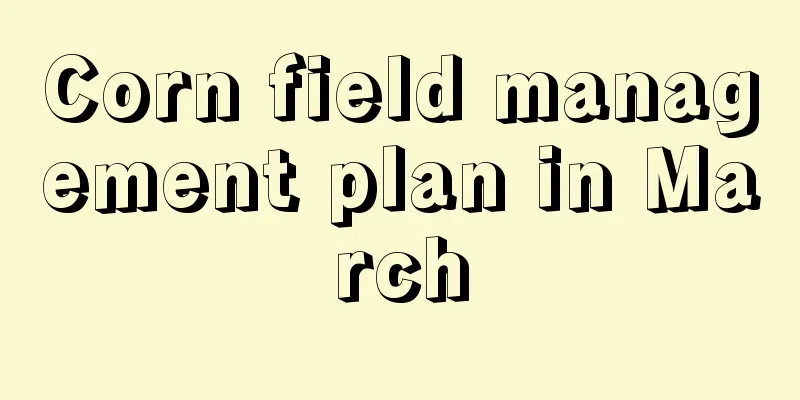Corn field management plan in March

|
Corn is one of the four major crops in my country and occupies a very important position in grain production. If you want high corn yields, you need to strengthen field management and create good conditions for the healthy growth of corn. Let’s talk about the corn field management plan in March. 1. Fine land preparation Spring-sown corn requires deep plowing. If there is a previous crop, the stubble should be killed in time after harvest, and then organic fertilizer should be applied for deep plowing. The tillage depth should be about 20cm. In areas where spring drought is severe, continuous pressing and raking operations are used to compact the soil, which is more conducive to increasing and retaining moisture. 2. Sowing time Generally, it is more suitable to sow when the temperature of the soil layer 5-10cm above the surface is stable at 10℃-12℃. Therefore, the suitable sowing time for spring corn is generally from March to May, depending on the regional temperature environment. 3. Seed treatment The purpose of corn seed treatment is to increase the germination rate and promote early germination of seeds. There are many methods, such as soaking seeds in cold water for 6-8 hours, or soaking seeds in warm water for 4-5 hours. In addition, you can also use coating agents to treat the seeds, such as using 2% of Likeshow to mix the seeds. 4. Reasonable density planting The planting density in plots with higher soil fertility is generally around 4,500 plants; in plots with lower soil fertility, it is appropriate to have around 4,000 plants per mu. It is best to plant at a reasonable density as required by the variety instructions. Please refer to the instructions on the back of the seed package for details. 5. Fertilizer and water management Apply 40kg-50kg of compound fertilizer (17-17-17) per mu as base fertilizer . If conditions permit, add 1t-2t of organic fertilizer per mu. Apply urea once during the seedling stage, with a dosage of 10-15kg/mu. Apply urea and compound fertilizer according to the seedling condition during the flaring stage before heading. 6. Pest and disease control During the seedling stage, the main prevention is stem rot. Common chemical control methods include 1000 times diluted 80% mancozeb wettable powder , 500 times diluted 50% carbendazim wettable powder, etc. Before planting, you can also spread lime or choose crop rotation to reduce pathogens. To control corn borers before male emergence, use 1000 times diluted chlorpyrifos and indoxacarb and 1000 times diluted 6% chlorpyrifos and cypermethrin for joint control. That’s it |
<<: How to fertilize Kalanchoe, symptoms of overfertilization
>>: How to grow Kalanchoe to make it bloom? What is the reason for it not blooming?
Recommend
Time and method of changing soil of red sandalwood
Time to change the soil of red sandalwood For sma...
How to grow clematis
Clematis Growing Conditions Clematis likes light ...
The role of yellow cicada
The ornamental value of yellow candy cane The yel...
What kind of plant is the iron tree and how to plant its seeds
1. What is the plant? The scientific name of the ...
The difference between purple root orchid and amaryllis
Differences between species and bulbs Purple Root...
Industrial pepper planting technology and management
Industrial peppers are a type of pepper with a ve...
The best way to disinfect vegetable soil: a simple and effective way to disinfect the soil before planting vegetables
How to disinfect the land before planting vegetab...
How to change the soil for a smooth sailing and what is the time and method of changing the soil
When is the right time to change the soil? In the...
Air purifying plants indoor flowers
1. Tiger Piranha Tiger Pira is a very popular pla...
How to propagate Fragrant wood
The success rate of propagation of Fragrant Wood ...
What to do if the leaves of the succulent money tree become soft and wrinkled
1. Replace the potting soil Reason: The money tre...
Can the fortune tree be exposed to the sun? Four seasons of light and maintenance methods
1. Whether you can get sun exposure The money tre...
What are the common pests of aloe vera?
Aloe bollworm The cotton bollworm is the most dan...
Cultivation methods and precautions of bicolor jasmine
1. Maintenance methods 1. Temperature: Between 18...
The effect of the queen flower
1. Cough relief The queen flower is cold in natur...









